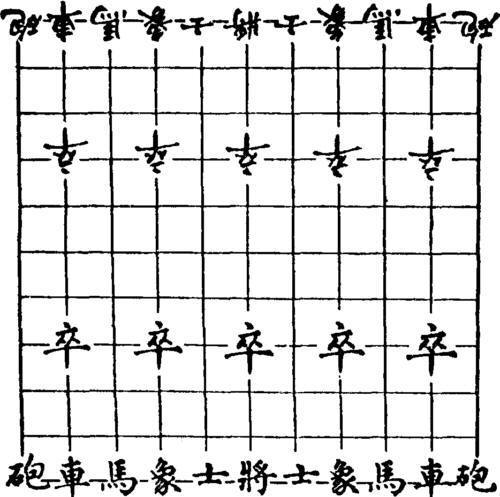Chapter 36 Section 6 Elephant Play
Elephant opera is an ancient chess game that was popular in the Northern Song Dynasty.It is actually a variant of the chess shape in the Northern Song Dynasty.
Li Qingzhao, a poetess at the end of the Northern Song Dynasty, said in her "The Book of Horse Fighting Preface" that there is only room for two people in big and small elephant plays and chess.Here, the bigness of the elephant play and the smallness of the small elephant play are only relative terms.Just as the "nine-nine chess" (the chessboard is composed of 9 × 9 squares) introduced into Japan by our country in the Northern Song Dynasty is called "small shogi", and another kind of chess with nine vertical and horizontal 13-way chessboards is called "big shogi".After the middle of the Northern Song Dynasty in my country, in addition to the "Seven Kingdoms Xiangxi" and "Guangxiang Opera", there were "Nine Nine Xiangqi" and chess with 11 vertical and horizontal chessboards.This latter chessboard with 11 vertical and horizontal chessboards is exactly "elephant play".
Regarding the chess system of Daxiang Opera, we can only know a little bit from Song Chaobuzhi's "Guangxiang Opera Preface".This is the chessboard with 11 vertical and horizontal paths, 32 chess pieces, divided into two armies to fight.In this regard, Yu Zhengxie of the Qing Dynasty's textual research in "Gui Si Cun Manuscript" said:
Song Chao Buzhi wrote "Guangxiang Opera Picture": Xiangqi has 11 vertical and horizontal chess pieces and 32 chess pieces. Try to expand it with 19 vertical and horizontal chess pieces and 98 chess pieces.Its new and old two are all different from the chessboard of modern chess, which has 10 vertical and horizontal nine roads.The ancient 11th road, Gai soldiers went to the third of the middle road, today's second middle road, the first road, the cannons are located on both sides, and the soldiers are located on the second, fourth, sixth, eighth, and tenth of the vertical road. The horse walks by the side, and the soldiers can't get out of the curtain (Nine Palaces), and the three of them can't start a war.
A close friend, Yu Pingbo, also proposed "Guangxiang Opera Picture" in "Qiu Liting Moyao".
It is inappropriate to call this kind of chess system "Guangxiang Opera Picture", because "Guangxiang Opera" has been named "Zonghenglu 19" in Chao Buzhi's preface, and Chao Buzhi got the name from the expansion of Zongheng 11 Lu chess. Therefore, the "Guangxiang Opera Picture" proposed by Yu Pingbo should be changed to "Daxiang Opera Picture".In addition, there are four points that need to be explained.

Yu Pingbo drafted "Elephant Play Picture"
(1) Sima Guang's "Seven Kingdoms Elephant Opera" and Cheng Hao's "Nine Nine Chess" both discarded the elephant and did not use it, but Chao Xuzhong said, "The elephant is the hero of the beast, so the opera soldiers are named after the elephant".This shows that there are elephants in the elephant play.
(2) In the era of Chao Buzhi, there was no mention of Shi as a chess piece in various documents.This shows that "shi" had not yet appeared at that time. Was the position of "shi" replaced by Pianbi?
(3) There is a cannon in Sima Guang's "Seven Kingdoms Elephant Opera".There are no cannons in Cheng Hao's "Nine Nine Elephants", which shows that the increase or decrease of cannons has not yet been finalized at that time. The reason why "elephant play" has increased from "nine-nine chess" to 11 vertical and horizontal lines may be that each side adds two cannons.
(4) Eight-eight chess and nine-nine chess are played on the squares of the chessboard. Sima Guang's "Seven Kingdoms Xiangxi" and Chao Buzhi's "Guangxiang Opera" are changed to the intersection of lines and lines. Go up chess. "Elephant Play" is also a game of chess at the intersection of the line and the line, which is the reason why it is unified with the form of Go in our country.

Yu Pingbo drafted "Elephant Play Picture"
